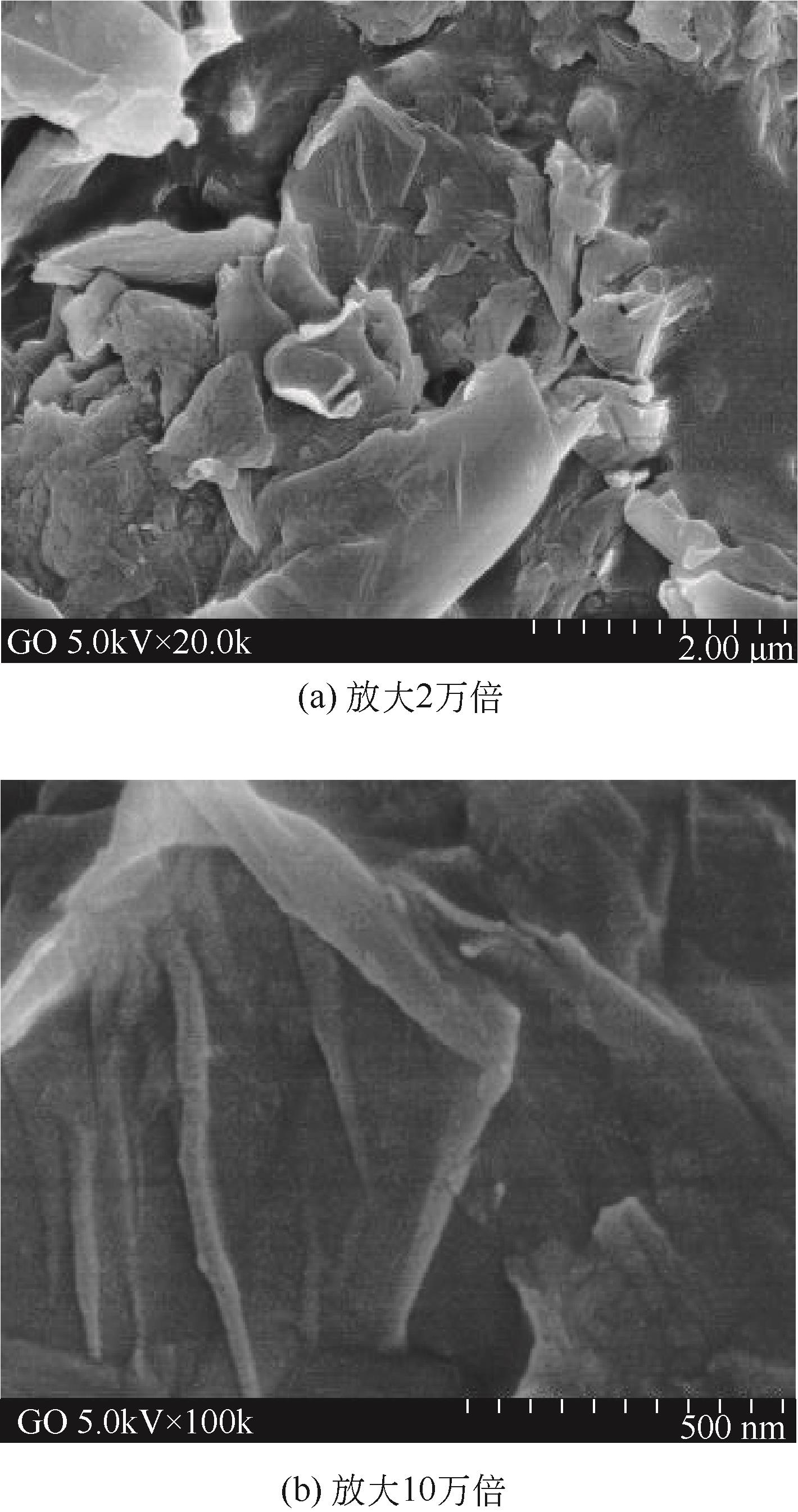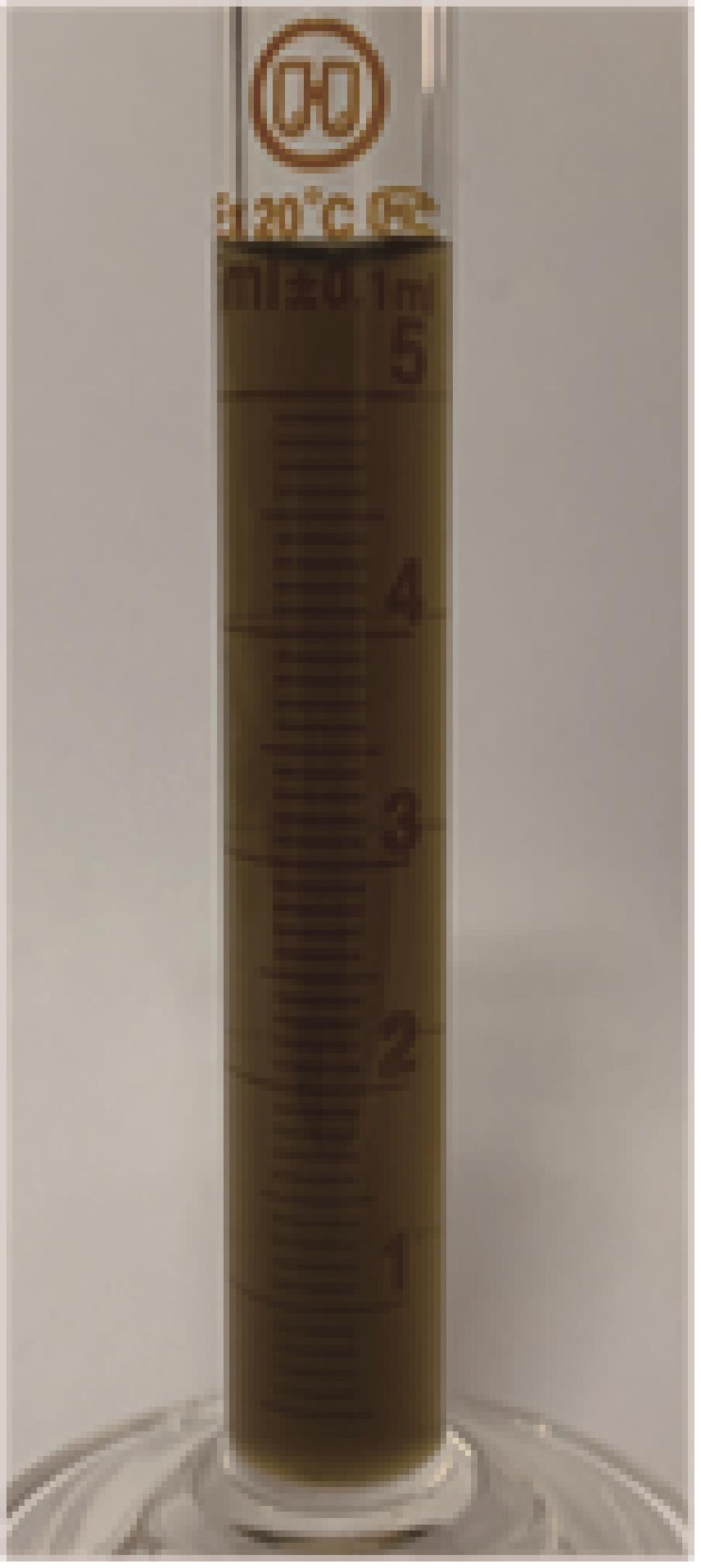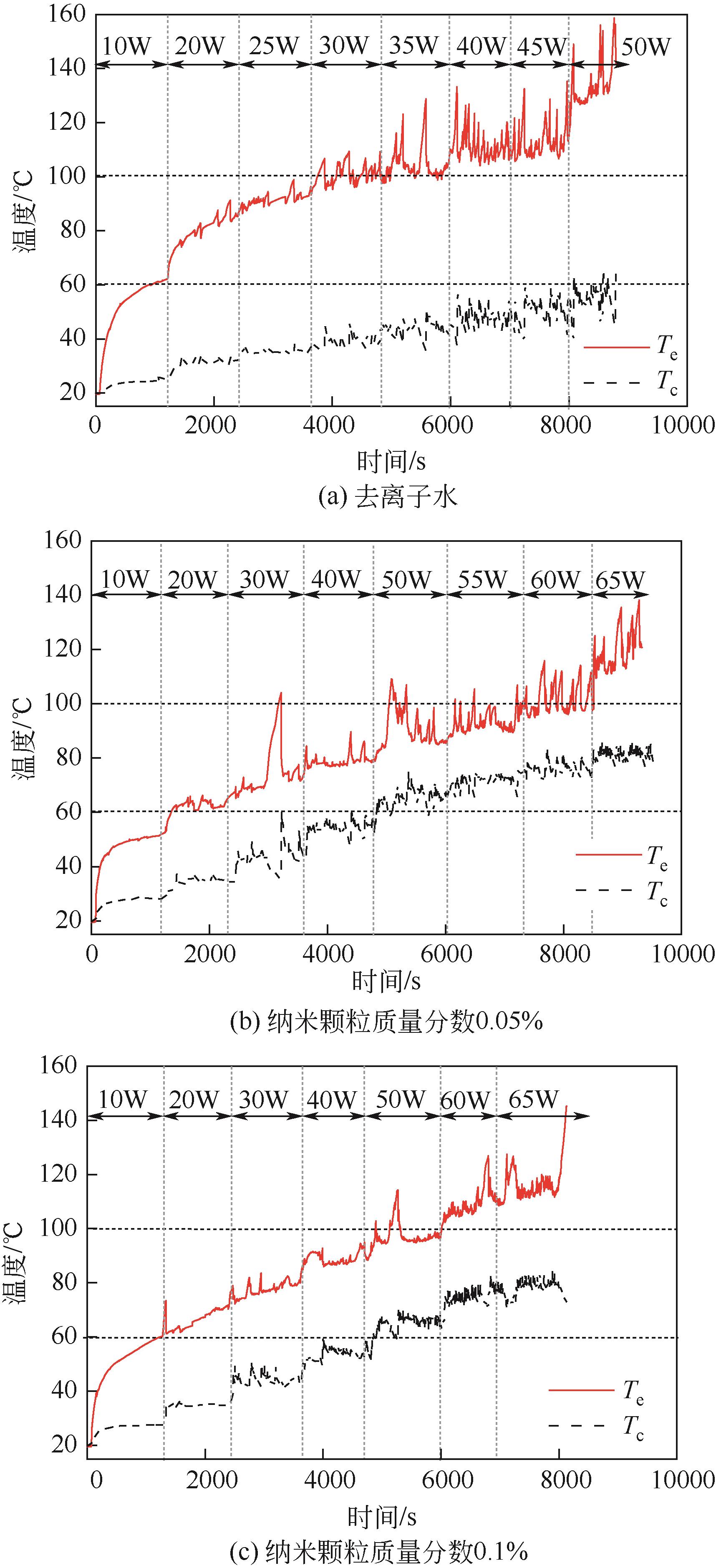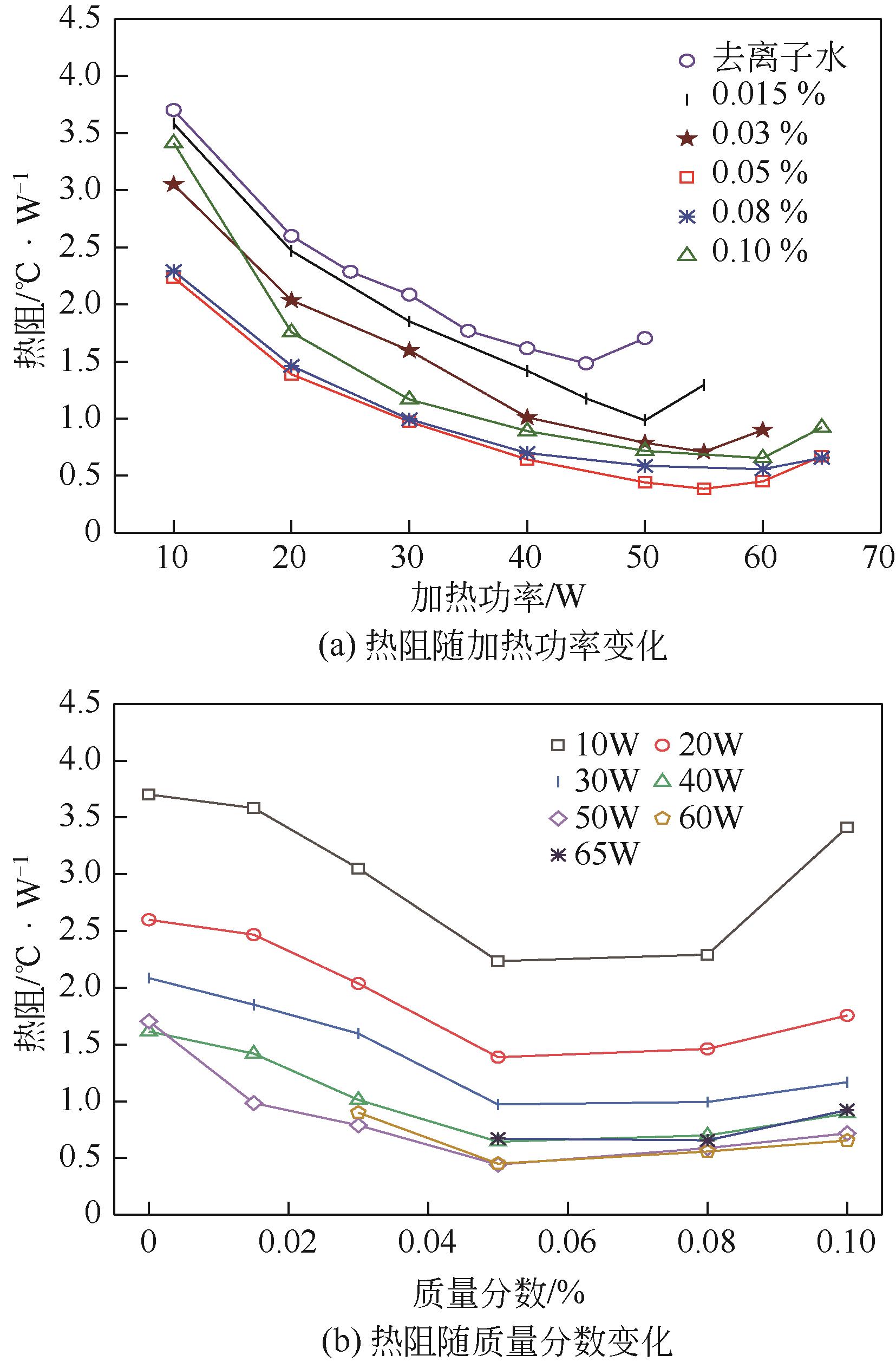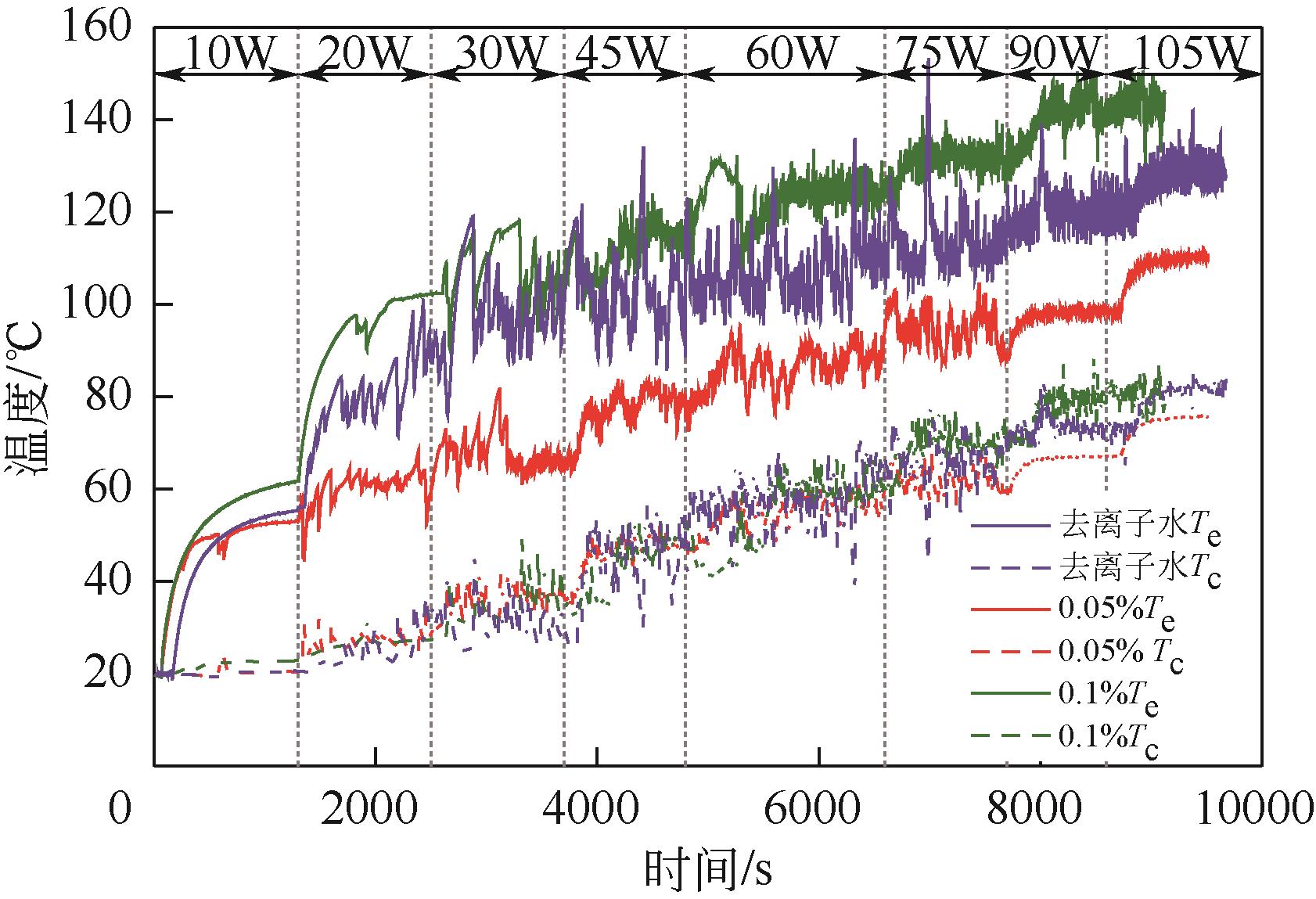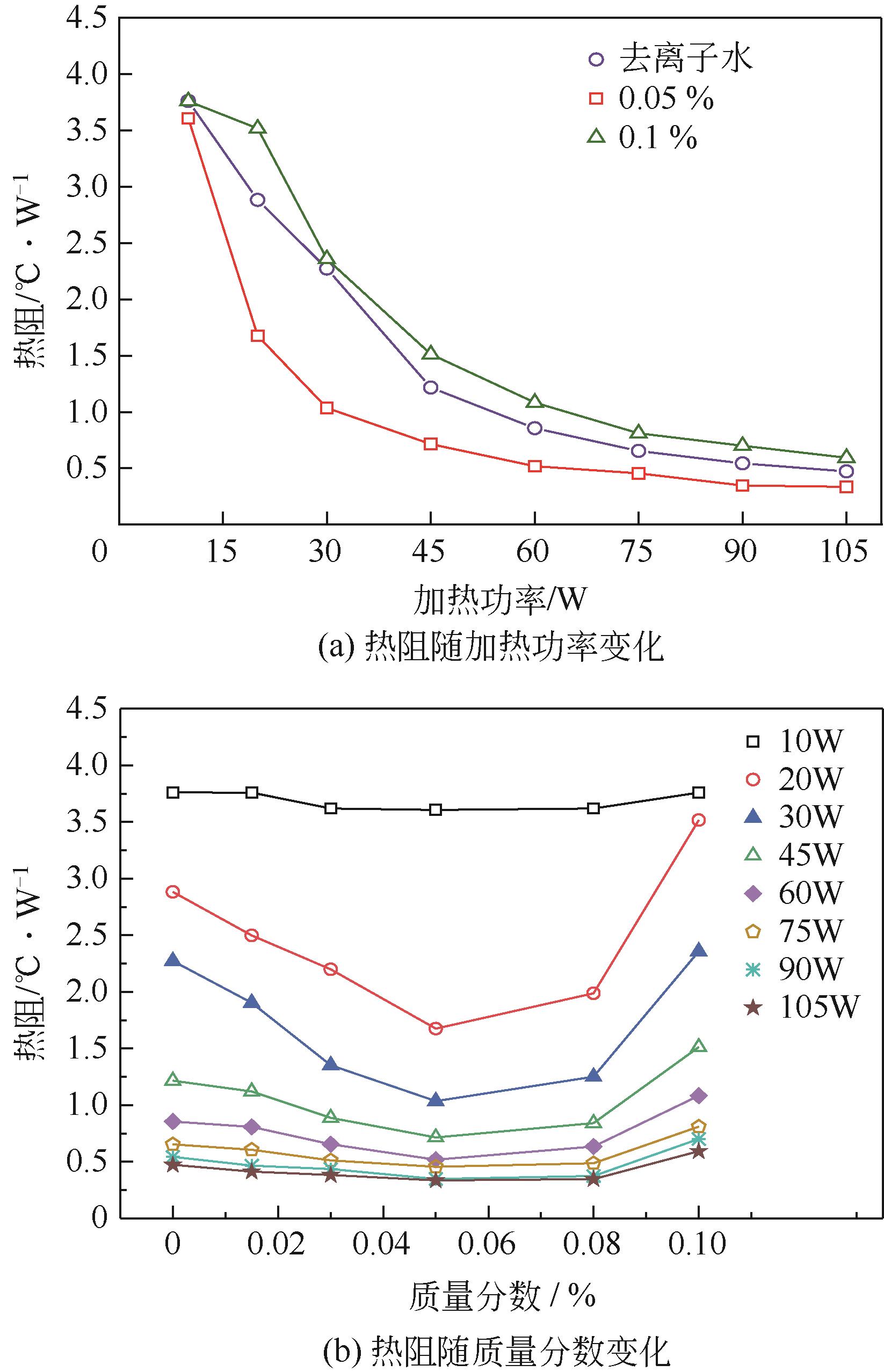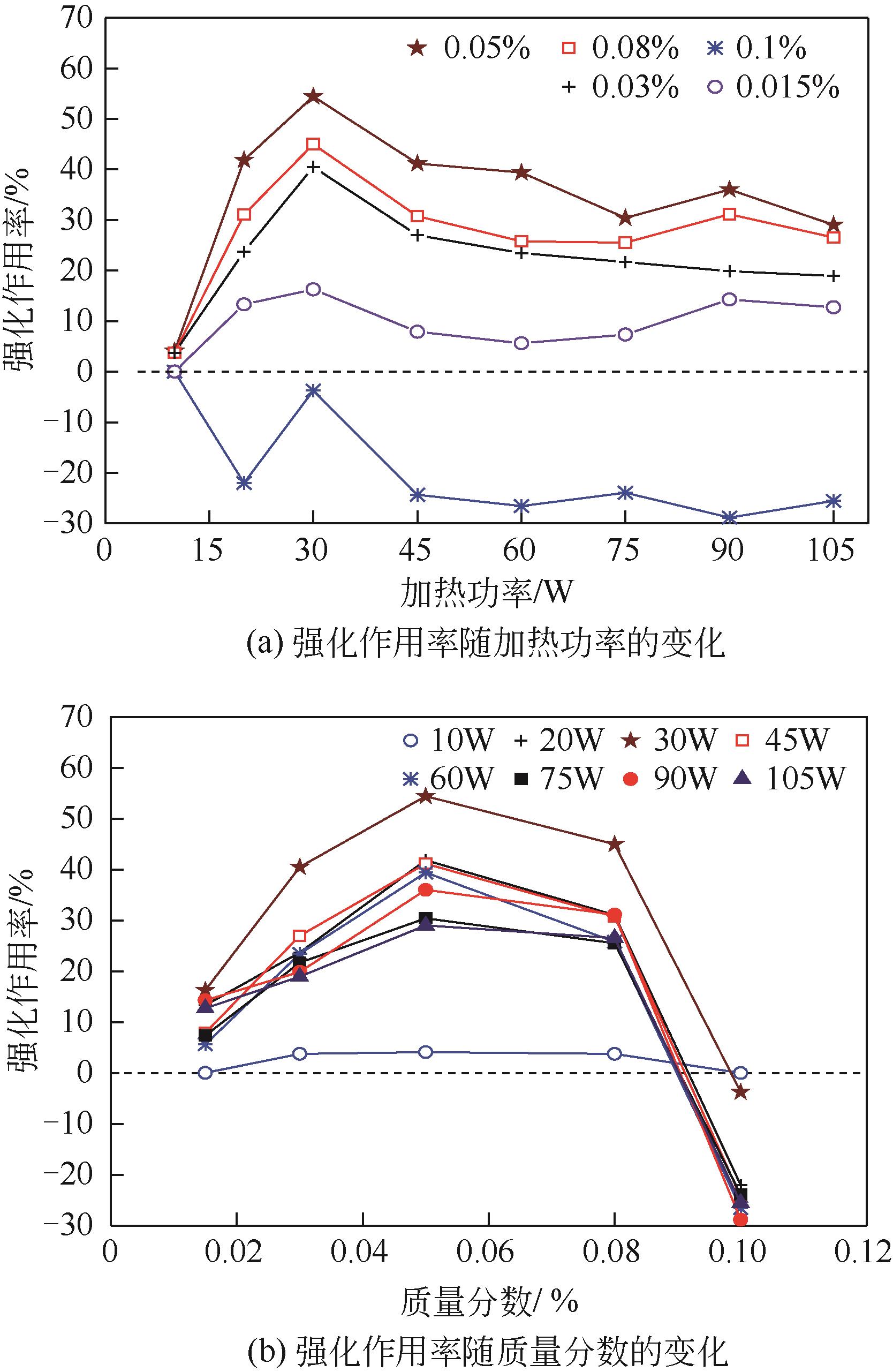Chemical Industry and Engineering Progress ›› 2022, Vol. 41 ›› Issue (4): 1725-1734.DOI: 10.16085/j.issn.1000-6613.2021-0769
• Chemical processes and equipment • Previous Articles Next Articles
Heat transfer performance enhancement and prediction in GO/water pulsating heat pipe
YANG Honghai( ), ZHANG Miao, LIU Liwei, ZHOU Yi, SHEN Junjie, SHI Weigang, YIN Yong
), ZHANG Miao, LIU Liwei, ZHOU Yi, SHEN Junjie, SHI Weigang, YIN Yong
- School of Environmental Science and Engineering, Donghua University, Shanghai 201600, China
-
Received:2021-04-13Revised:2021-08-06Online:2022-04-25Published:2022-04-23 -
Contact:YANG Honghai
氧化石墨烯/水脉动热管传热强化及性能预测
杨洪海( ), 张苗, 刘利伟, 周屹, 沈俊杰, 施伟刚, 尹勇
), 张苗, 刘利伟, 周屹, 沈俊杰, 施伟刚, 尹勇
- 东华大学环境科学与工程学院,上海 201600
-
通讯作者:杨洪海 -
作者简介:杨洪海(1968—),女,教授,硕士生导师,研究方向为传热及强化、热能利用与节能技术等。E-mail:yhh@dhu.edu.cn 。 -
基金资助:国家重点研发计划(2016YFB0601404)
CLC Number:
Cite this article
YANG Honghai, ZHANG Miao, LIU Liwei, ZHOU Yi, SHEN Junjie, SHI Weigang, YIN Yong. Heat transfer performance enhancement and prediction in GO/water pulsating heat pipe[J]. Chemical Industry and Engineering Progress, 2022, 41(4): 1725-1734.
杨洪海, 张苗, 刘利伟, 周屹, 沈俊杰, 施伟刚, 尹勇. 氧化石墨烯/水脉动热管传热强化及性能预测[J]. 化工进展, 2022, 41(4): 1725-1734.
share this article
Add to citation manager EndNote|Ris|BibTeX
URL: https://hgjz.cip.com.cn/EN/10.16085/j.issn.1000-6613.2021-0769
| 作者 | 工质及GO质量分数/% | 充液率/% | 加热功率/W | 蒸发段长/mm | 绝热段长/mm | 冷凝段长/mm | 弯头 |
|---|---|---|---|---|---|---|---|
| Cui等[ | GNP/水:0.01,0.025,0.05,0.075,0.08,0.1 | 45~90 | 10~100① | 80 | 20 | 95 | 5 |
| Su等[ | GO/水:0.05,0.1 GO/正丁醇水溶液:0.014 | 50 | 10~100② | 50 | 200 | 50 | 3 |
| Nazari等[ | GO/水:0.025,0.05,0.1,0.15 | 50 | 10~70② | 75 | 95 | 208 | 2 |
| 本文作者 | GO/水:0.015,0.03,0.05,0.08,0.1 | 30~80 | 10~105① | 75 | 20 | 100 | 3 |
| 作者 | 工质及GO质量分数/% | 充液率/% | 加热功率/W | 蒸发段长/mm | 绝热段长/mm | 冷凝段长/mm | 弯头 |
|---|---|---|---|---|---|---|---|
| Cui等[ | GNP/水:0.01,0.025,0.05,0.075,0.08,0.1 | 45~90 | 10~100① | 80 | 20 | 95 | 5 |
| Su等[ | GO/水:0.05,0.1 GO/正丁醇水溶液:0.014 | 50 | 10~100② | 50 | 200 | 50 | 3 |
| Nazari等[ | GO/水:0.025,0.05,0.1,0.15 | 50 | 10~70② | 75 | 95 | 208 | 2 |
| 本文作者 | GO/水:0.015,0.03,0.05,0.08,0.1 | 30~80 | 10~105① | 75 | 20 | 100 | 3 |
| 参数 | 不确定度/% |
|---|---|
| Te | ±0.28 |
| Tc | ±0.57 |
| Q | ±2.9 |
| R | ±5.0 |
| q | ±5.02 |
| 参数 | 不确定度/% |
|---|---|
| Te | ±0.28 |
| Tc | ±0.57 |
| Q | ±2.9 |
| R | ±5.0 |
| q | ±5.02 |
| 1 | XU Y Y, XUE Y Q, QI H, et al. An updated review on working fluids, operation mechanisms, and applications of pulsating heat pipes[J]. Renewable and Sustainable Energy Reviews, 2021, 144: 110995. |
| 2 | BASTAKOTI D, ZHANG H N, LI D, et al. An overview on the developing trend of pulsating heat pipe and its performance[J]. Applied Thermal Engineering, 2018, 141: 305-332. |
| 3 | 冯剑超, 曲伟. 纳米流体脉动热管的性能实验[J]. 中国科学院研究生院学报, 2009, 26(1): 50-57. |
| FENG Jianchao, QU Wei. Experimental investigation of heat transfer performance of nanofluid pulsating heat pipes[J]. Journal of the Graduate School of the Chinese Academy of Sciences, 2009, 26(1): 50-57. | |
| 4 | JI Y L, MA H B, SU F M, et al. Particle size effect on heat transfer performance in an oscillating heat pipe[J]. Experimental Thermal and Fluid Science, 2011, 35(4): 724-727. |
| 5 | KARTHIKEYAN V K, RAMACHANDRAN K, PILLAI B C, et al. Effect of nanofluids on thermal performance of closed loop pulsating heat pipe[J]. Experimental Thermal and Fluid Science, 2014, 54: 171-178. |
| 6 | WU Q P, XU R J, WANG R X, et al. Effect of C60 nanofluid on the thermal performance of a flat-plate pulsating heat pipe[J]. International Journal of Heat and Mass Transfer, 2016, 100: 892-898. |
| 7 | ZUFAR M, GUNNASEGARAN P, KUMAR H M, et al. Numerical and experimental investigations of hybrid nanofluids on pulsating heat pipe performance[J]. International Journal of Heat and Mass Transfer, 2020, 146: 118887. |
| 8 | QU J, WU H Y, CHENG P. Thermal performance of an oscillating heat pipe with Al2O3-water nanofluids[J]. International Communications in Heat and Mass Transfer, 2010, 37(2): 111-115. |
| 9 | LI Q M, ZOU J, YANG Z, et al. Visualization of two-phase flows in nanofluid oscillating heat pipes[J]. Journal of Heat Transfer, 2011, 133(5): 052901. |
| 10 | MEHRALI M, SADEGHINEZHAD E, LATIBARI S T, et al. Investigation of thermal conductivity and rheological properties of nanofluids containing graphene nanoplatelets[J]. Nanoscale Research Letters, 2014, 9(1): 15. |
| 11 | LEE G J, RHEE C K. Enhanced thermal conductivity of nanofluids containing graphene nanoplatelets prepared by ultrasound irradiation[J]. Journal of Materials Science, 2014, 49(4): 1506-1511. |
| 12 | SARSAM W S, AMIRI A, KAZI S N, et al. Stability and thermophysical properties of non-covalently functionalized graphene nanoplatelets nanofluids[J]. Energy Conversion and Management, 2016, 116: 101-111. |
| 13 | 张飞龙, 王莉, 俞树荣, 等. 氧化石墨烯及其导热纳米流体的制备与性能[J]. 功能材料, 2015, 46(16): 16138-16141. |
| ZHANG Feilong, WANG Li, YU Shurong, et al. Preparation and properties of graphene oxide and theirthermal conductivity nanofluids[J]. Journal of Functional Materials, 2015, 46(16): 16138-16141. | |
| 14 | 施赛燕, 崔晓钰, 周宇, 等. 石墨烯/去离子水纳米流体振荡热管传热性能[J]. 化工学报, 2016, 67(12): 4944-4950. |
| SHI Saiyan, CUI Xiaoyu, ZHOU Yu, et al. Heat transfer performance of pulsating heat pipe with graphene aqueous nanofluids[J]. CIESC Journal, 2016, 67(12): 4944-4950. | |
| 15 | ZHOU Y, CUI X Y, WENG J H, et al. Experimental investigation of the heat transfer performance of an oscillating heat pipe with graphene nanofluids[J]. Powder Technology, 2018, 332: 371-380. |
| 16 | SU X J, ZHANG M, HAN W, et al. Enhancement of heat transport in oscillating heat pipe with ternary fluid[J]. International Journal of Heat and Mass Transfer, 2015, 87: 258-264. |
| 17 | 张明, 苏新军, 韩魏, 等. 氧化石墨烯/自湿润流体脉动热管的传热特性[J]. 化工进展, 2015, 34(8): 2951-2954. |
| ZHANG Ming, SU Xinjun, HAN Wei, et al. Heat transfer characteristics of pulsating heat pipe with graphene oxide/self-rewetting fluid[J]. Chemical Industry and Engineering Progress, 2015, 34(8): 2951-2954. | |
| 18 | 韩魏, 苏新军, 张明, 等. 氧化石墨烯脉动热管传热性能实验研究[J]. 太阳能学报, 2016, 37(6): 1476-1480. |
| HAN Wei, SU Xinjun, ZHANG Ming, et al. Experimental study of thermal performance of pulsating heat pipe with graphene oxide[J]. Acta Energiae Solaris Sinica, 2016, 37(6): 1476-1480. | |
| 19 | NAZARI M A, GHASEMPOUR R, AHMADI M H, et al. Experimental investigation of graphene oxide nanofluid on heat transfer enhancement of pulsating heat pipe[J]. International Communications in Heat and Mass Transfer, 2018, 91: 90-94. |
| 20 | CACUA K, BUITRAGO-SIERRA R, PABÓN E, et al. Nanofluids stability effect on a thermosyphon thermal performance[J]. International Journal of Thermal Sciences, 2020, 153: 106347. |
| 21 | KHANDEKAR S, CHAROENSAWAN P, GROLL M, et al. Closed loop pulsating heat pipes Part B: Visualization and semi-empirical modeling[J]. Applied Thermal Engineering, 2003, 23(16): 2021-2033. |
| 22 | SHAFII M B, ARABNEJAD S, SABOOHI Y, et al. Experimental investigation of pulsating heat pipes and a proposed correlation[J]. Heat Transfer Engineering, 2010, 31(10): 854-861. |
| 23 | YEBOAH S K, DARKWA J. Thermal performance of a novel helically coiled oscillating heat pipe (HCOHP) for isothermal adsorption. An experimental study[J]. International Journal of Thermal Sciences, 2018, 128: 49-58. |
| 24 | SCHMULLER J. Statistical analysis with excel for dummies[J]. Wiley & Sons, 2013. |
| 25 | HALIMI M, ABBAS NEJAD A, NOROUZI M. A comprehensive experimental investigation of the performance of closed-loop pulsating heat pipes[J]. Journal of Heat Transfer, 2017, 139(9): 092003. |
| 26 | 杨洪海, 林天伦, 万勍, 等. 开式脉动热管传热极限的试验研究[J]. 动力工程, 2009, 29(10): 936-940. |
| YANG Honghai, LIN Tianlun, WAN Qing, et al. Experimental study on heat transfer limit of open loop pulsating heat pipes[J]. Journal of Power Engineering, 2009, 29(10): 936-940. | |
| 27 | YANG H H, KHANDEKAR S, GROLL M. Operational limit of closed loop pulsating heat pipes[J]. Applied Thermal Engineering, 2008, 28(1): 49-59. |
| 28 | 毛兰, 周文斌, 胡学功, 等. 氧化石墨烯表面的饱和池沸腾强化传热实验[J]. 化工进展, 2019, 38(9): 4164-4173. |
| MAO Lan, ZHOU Wenbin, HU Xuegong, et al. Enhanced pool boiling heat transfer performance on graphene oxide nanocoating surface[J]. Chemical Industry and Engineering Progress, 2019, 38(9): 4164-4173. | |
| 29 | 尹大燕, 贾力. 振荡热管管内流型对传热性能的影响[J]. 应用基础与工程科学学报, 2007, 15(3): 363-368. |
| YIN Dayan, JIA Li. The influence of flow patterns on heat transfer characteristic of oscillating heat pipe[J]. Journal of Basic Science and Engineering, 2007, 15(3): 363-368. | |
| 30 | 王宇, 李惟毅. 充液率对单环路脉动热管启动运行的影响[J]. 中国电机工程学报, 2011, 31(17): 79-85. |
| WANG Yu, LI Weiyi. Influence of filling ratio on startup and operation of a single loop pulsating heat pipe[J]. Proceedings of the CSEE, 2011, 31(17): 79-85. | |
| 31 | YANG H H, KHANDEKAR S, GROLL M. Performance characteristics of pulsating heat pipes as integral thermal spreaders[J]. International Journal of Thermal Sciences, 2009, 48(4): 815-824. |
| 32 | JO J, KIM J, KIM S J. Experimental investigations of heat transfer mechanisms of a pulsating heat pipe[J]. Energy Conversion and Management, 2019, 181: 331-341. |
| 33 | YUAN D Z, QU W, MA T Z. Flow and heat transfer of liquid plug and neighboring vapor slugs in a pulsating heat pipe[J]. International Journal of Heat and Mass Transfer, 2010, 53(7/8): 1260-1268. |
| 34 | RITTIDECH S, PIPATPAIBOON N, TERDTOON P. Heat-transfer characteristics of a closed-loop oscillating heat-pipe with check valves[J]. Applied Energy, 2007, 84(5): 565-577. |
| 35 | LIN Z R, WANG S F, CHEN J J, et al. Experimental study on effective range of miniature oscillating heat pipes[J]. Applied Thermal Engineering, 2011, 31(5): 880-886. |
| 36 | HAN X H, WANG X H, ZHENG H C, et al. Review of the development of pulsating heat pipe for heat dissipation[J]. Renewable and Sustainable Energy Reviews, 2016, 59: 692-709. |
| 37 | QU J, WANG Q. Experimental study on the thermal performance of vertical closed-loop oscillating heat pipes and correlation modeling[J]. Applied Energy, 2013, 112: 1154-1160. |
| 38 | LIANG Q Q, HAO T T, WANG K, et al. Startup and transport characteristics of oscillating heat pipe using ionic liquids[J]. International Communications in Heat and Mass Transfer, 2018, 94: 1-13. |
| 39 | EBRAHIMI DEHSHALI M, NAZARI M A, SHAFII M B. Thermal performance of rotating closed-loop pulsating heat pipes: experimental investigation and semi-empirical correlation[J]. International Journal of Thermal Sciences, 2018, 123: 14-26. |
| 40 | PAK B C, CHO Y I. Hydrodynamic and heat transfer study of dispersed fluids with submicron metallic oxide particles[J]. Experimental Heat Transfer, 1998, 11(2): 151-170. |
| 41 | SAID Z, ABDELKAREEM M A, REZK H, et al. Stability, thermophysical and electrical properties of synthesized carbon nanofiber and reduced-graphene oxide-based nanofluids and their hybrid along with fuzzy modeling approach[J]. Powder Technology, 2020, 364: 795-809. |
| 42 | 刘利伟. 氧化石墨烯脉动热管传热特性及实验关联式的研究[D]. 上海: 东华大学, 2020. |
| LIU Liwei. Study on heat transfer characteristics and experimental correlation of graphene oxide pulsating heat pipe[D]Shanghai: Donghua University,2020. | |
| 43 | 郑兆志, 何钦波, 刘玉东. 水基氧化石墨烯纳米流体表面张力实验研究[J]. 热科学与技术, 2015, 14(3): 203-207. |
| ZHENG Zhaozhi, HE Qinbo, LIU Yudong. Experimental investigation on surface tension of water-based graphene oxide nanofluids[J]. Journal of Thermal Science and Technology, 2015, 14(3): 203-207. | |
| 44 | IJAM A, SAIDUR R, GANESAN P, et al. Stability, thermo-physical properties, and electrical conductivity of graphene oxide-deionized water/ethylene glycol based nanofluid[J]. International Journal of Heat and Mass Transfer, 2015, 87: 92-103. |
| [1] | HUI Bo, HOU Hongyi, ZHANG Tao, CHE Shengwen. Drying characteristics of cylindrical annular pulsating heat pipe [J]. Chemical Industry and Engineering Progress, 2023, 42(S1): 33-40. |
| [2] | XU Chunshu, YAO Qingda, LIANG Yongxian, ZHOU Hualong. Effects of graphene oxide/carbon nanotubes on the properties of several typical polymer materials [J]. Chemical Industry and Engineering Progress, 2023, 42(6): 3012-3028. |
| [3] | HE Yang, LI Siying, LI Chuanqiang, YUAN Xiaoya, ZHENG Xuxu. Anticorrosion performance of thermal reduction graphene oxide /epoxy resin composite coating [J]. Chemical Industry and Engineering Progress, 2023, 42(4): 1983-1994. |
| [4] | YU Junsheng, ZHU Ye, LI Qiankun, XU Shixuan, ZHANG Xinyang, WANG Cheng, QU Jian. Performance of pulsating heat pipe with rising and declining heat flux [J]. Chemical Industry and Engineering Progress, 2023, 42(3): 1178-1186. |
| [5] | ZHANG Jianwei, XU Rui, ZHANG Zhongchuang, DONG Xin, FENG Ying. Mixing characteristics of concentration field in impingement flow reactor based on convolutional neural network [J]. Chemical Industry and Engineering Progress, 2023, 42(2): 658-668. |
| [6] | GUO Zhipeng, BU Xianbiao, LI Huashan, GONG Yulie, WANG Lingbao. Numerical simulation of heat extraction in single-well enhanced geothermal system based on thermal-hydraulic-chemical coupling model [J]. Chemical Industry and Engineering Progress, 2023, 42(2): 711-721. |
| [7] | SUN Yiming, RAN Baoqing, BIAN Wuxun, LIU Jinchao, YIN Shaoding, ZHAO Xipo. Preparation and process optimization of polypropylene wax solid-solid phase change material [J]. Chemical Industry and Engineering Progress, 2023, 42(1): 336-345. |
| [8] | QIN Zhenfang, LIAO Rihong, MA Weifang. Research progress on absorption-microalgae fixation of low concentration CO2 and synchronous oil production in gas power plant [J]. Chemical Industry and Engineering Progress, 2023, 42(1): 94-106. |
| [9] | ZHANG Xinhai, ZHAO Sichen, ZHU Hui, ZHANG Shoushi, WANG Kai. Comparative study on desulfurization performance of various carbon materials combined with sodium carbonate [J]. Chemical Industry and Engineering Progress, 2022, 41(S1): 424-435. |
| [10] | PENG Deqi, FENG Yuan, WANG Yiran, TAN Zhuowei, YU Tianlan, WU Shuying. Distribution characteristics and convergence of particles in converging-diverging tube [J]. Chemical Industry and Engineering Progress, 2022, 41(9): 4662-4672. |
| [11] | YANG Chengyu, LIU Min, YUAN Lin, HU Xuan, CHEN Ying. Adsorption of low-concentration phosphorus after cross-linked modification of bamboo-based cellulose nanofibrils [J]. Chemical Industry and Engineering Progress, 2022, 41(9): 5074-5084. |
| [12] | XIONG Jian, XIA Liufen, YU Lei, FEI Anjie, XU Chu, CHEN Shengya, JIANG Guodong. Preparation and electrochromic properties of graphene oxide and TiO2-B composite films [J]. Chemical Industry and Engineering Progress, 2022, 41(7): 3794-3800. |
| [13] | LIU Shijie, MO Xun, TU Aimin, ZHU Dongsheng, TAN Lianyuan. Shell-side heat transfer enhancement of a novel longitudinal flow oil cooler [J]. Chemical Industry and Engineering Progress, 2022, 41(7): 3475-3482. |
| [14] | LI Yifan, WANG Zhipeng. Flow and heat transfer characteristics in microchannels with periodic fluid disturbance structures [J]. Chemical Industry and Engineering Progress, 2022, 41(6): 2893-2901. |
| [15] | CHEN Yong, CHENG Ning, YANG Yubing, LU Kailing, LUO Ying, YI Hui. Highly efficient adsorption of Basic Violet 3 dye by composite material derived from graphene oxide intercalated bentonite [J]. Chemical Industry and Engineering Progress, 2022, 41(6): 3324-3332. |
| Viewed | ||||||
|
Full text |
|
|||||
|
Abstract |
|
|||||

